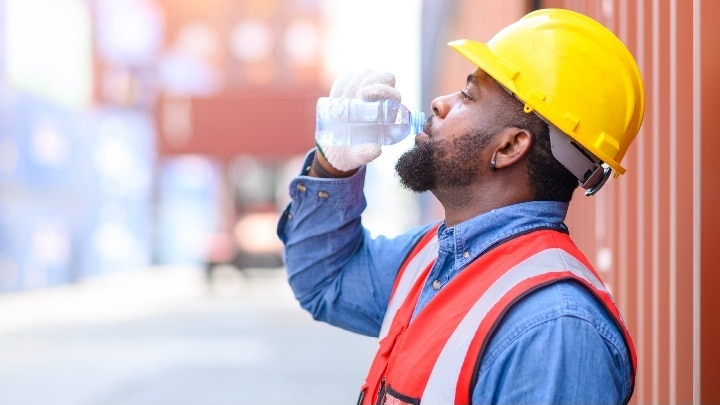
Workplace environments come in all shapes and sizes. There are offices and factories, construction yards and warehouses, airy laboratories and tight kitchens, carefully controlled climates and venues exposed to the elements. This variety of workplace environments means that workers can be exposed to a wide range of temperatures and temperature extremes. Exposures to heat and humidity — whether natural or artificial — often pose risks for employees.
Heat stress
Heat stress can be dangerous and refers to the body’s exposure to conditions that could strain its ability to regulate core body temperature, which is often impacted by a combination of environmental conditions such as temperature, humidity, wind speed, sun (solar load) and by activity that generates heat such as the physical exertion required by the work.
Although it’s common to think of heat mainly impacting outdoor workers on hot days, heat can also affect workers in indoor environments that contain significant heat sources, such as the workplaces of restaurant and bakery staff, miners, boiler room operators, and construction workers. Heat stress may be more likely to affect workers who are older, overweight, pregnant, have pre-existing health conditions, or who take medications that make them more susceptible to the heat.
Three major categories of heat illness can occur due to the body’s inability to cope with excessive heat:
1. Heat cramps
The mildest category of heat-related illness, heat cramps can occur when an individual sweats a lot and does not replace lost fluids and electrolytes. Symptoms can include muscle pains, cramps, and spasms – typically in the abdomen, arms, or legs.
Treatment can include resting in a cool place, lightly stretching and massaging affected muscles, and drinking non-alcoholic and caffeine-free beverages or juices to help replenish fluids and electrolytes. (Make sure to seek immediate medical attention if cramps last more than 1 hour)
2. Heat exhaustion
Heat exhaustion can occur due to dehydration and exposure to high temperatures and high humidity. Symptoms can include moist, clammy or pale skin, heavy sweating, headaches, dizziness, weakness, nausea or vomiting, and exhaustion. It is more likely to occur in individuals with a low level of cardiovascular fitness or those not acclimatized to heat.
Treatment can include giving sips of water or available cool fluids; removing excess clothes and loosening remaining clothing; putting cool wet towels or ice packs on neck, armpits and/or groin; if available, taking a cool shower, soaking in cool pond or stream, or moving to an air-conditioned room. (Make sure to seek immediate medical attention if the person vomits, symptoms worsen or last longer than 1 hour).
3. Heat stroke
Heat stroke is a medical emergency and may be fatal unless treated promptly and adequately. It can occur when the body is no longer able to cool itself and remove excess heat. Signs of heat stroke include hot red, dry, or damp skin; a rapid and sometimes weak pulse; shallow breathing; throbbing headache; nausea; dizziness; body temperature above 103°F; confusion; fainting; and changes in (or loss of) consciousness.
Call 911 or get the individual to a hospital immediately. Heat stroke is a severe medical emergency. Delay can be fatal. Move the individual out of the heat as soon as possible. Cool them down using fans, a cool bath, or a wet sheet. Move the victim to a cooler, preferably air-conditioned, environment. Reduce body temperature with cool cloths or bath. Avoid fluids if the individual is not fully conscious or is vomiting. NOTE: Using a fan to blow air in someone’s direction may actually make them hotter if heat index temperatures are above 90 degrees Fahrenheit.
Taking action
Exposure to heat can adversely affect workers’ health and safety, diminish work performance, and potentially expose employers to liability concerns. As weather patterns continue to change, workplaces that may not have been at risk previously for heat-related illnesses may now experience conditions that could place workers at risk.
A variety of control strategies can be used to help reduce the risk of heat-related illnesses. All strategies should include development and use of a heat stress management program.
General controls may include the following:
- A plan to promote hydration among workers. Workers should be encouraged to drink small amounts of cool water (about a cup) every 15 to 20 minutes.
- Ensuring workers become acclimatized to the hot environment by increasing work intensity and duration slowly.
- Heat Stress Management Program Assessment, RC 6142, covers additional points to consider including in your heat stress management program.
Engineering controls or modifications:
- Cool workspace with evaporative coolers or air conditioners.
- Block or shield heat produced by equipment that contributes to high work temperatures.
- Substitute a high-heat generating process for one that generates low heat.
- Provide power tools or mechanical equipment, such as conveyors, that help decrease manual labor tasks and reduce physical exertion.
Procedural controls:
- Perform labor-intensive tasks during the cooler part of the day.
- Provide a cool, shaded rest area.
- Spot cool by using portable air conditioners, fans, or mist fans.
- Educate workers in maintaining proper hydration.
- Provide water and encourage frequent drinking of small amounts (a cup of cool water about every 15 to 20 minutes).
Administrative controls:
- Implement a Heat Stress Management program and ensure all employees receive training.
- Allow workers to become acclimatized to the hot environment. Increase work intensity and duration slowly.
- Use a buddy system and train workers to recognize signs and symptoms of heat-related illnesses and appropriate first aid measures.
It’s important to involve all members of the workforce in creating temperature-safe environments. Employees and supervisors should know the importance of proper fluid intake and electrolyte replacement, be able to recognize signs of heat-related illnesses, know how to provide appropriate first aid, and how and when to contact emergency personnel.
Additional resources
From Liberty Mutual Risk Control:
From OSHA:
To learn more about how Liberty Mutual helps business anticipate and mitigate risks, visit our risk control page.
Featured insights
This website is general in nature, and is provided as a courtesy to you. Information is accurate to the best of Liberty Mutual’s knowledge, but companies and individuals should not rely on it to prevent and mitigate all risks as an explanation of coverage or benefits under an insurance policy. Consult your professional advisor regarding your particular facts and circumstance. By citing external authorities or linking to other websites, Liberty Mutual is not endorsing them.



